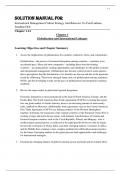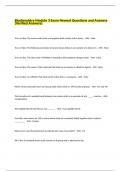1-1
Solution Manual For
International Management Culture Strategy And Behavior 11e Fred Luthans,
Jonathan Doh
Chapter 1-14
Chapter 1
Globalization and International Linkages
Learning Objectives and Chapter Summary
1. Assess the implications of globalization for countries, industries, firms, and communities.
Globalization—the process of increased integration among countries—continues at an
accelerated pace. More and more companies—including those from developing
countries—are going global, creating opportunities and challenges for the global economy
and international management. Globalization has become controversial in some quarters
due to perceptions that the distributions of its benefits are uneven and due to the questions
raised by offshoring. There have emerged sharp critics of globalization among academics,
NGOs, and the developing world, yet the pace of globalization and integration continues
unabated.
2. Review the major trends in global and regional integration.
Economic integration is most pronounced in the triad of North America, Europe, and the
Pacific Rim. The North American Free Trade Agreement (NAFTA) is turning the region
into one giant market. In South America, there is an increasing amount of intercountry
trade, sparked by Mercosur. Additionally, trade agreements such as the Central American
Free Trade Agreement (CAFTA) are linking countries of the Western Hemisphere
together. In Europe, the expansion of the original countries of the European Union (EU) is
creating a larger and more diverse union, with dramatic transformation of Central and
Eastern European countries such as the Czech Republic, Poland, and Hungary. Asia is
another major regional power, as reflected in the rapid growth shown not only by Japan,
but also the economies of China, India, and other emerging markets. Countries in Africa
and the Middle East continue to face complex problems but still hold economic promise
for the future. Emerging markets in all regions present both opportunities and challenges
for international managers.
3. Examine the changing balance of global economic power and trade and investment flows
, 1-2
among countries.
Different growth rates and shifting demographics are dramatically altering the distribution
of economic power around the world. Notably, China‘s rapid growth will make it the
largest economic power in the world by midcentury, if not before. India will be the most
populous country in the world, and other emerging markets will also become important
players. International trade and investment have been increasing dramatically over the
years. Major multinational corporations (MNCs) have holdings throughout the world, from
North America to Europe to the Pacific Rim to Africa. Some of these holdings are a result
of direct investment; others are partnership arrangements with local firms. Small firms also
are finding that they must seek out international markets to survive in the future. MNCs
from emerging markets are growing rapidly and expanding their global reach. The
internationalization of nearly all business has arrived.
4. Analyze the major economic systems and recent developments among countries that reflect
those systems.
Different economic systems characterize different countries and regions. These systems,
which include market, command, and mixed economies, are represented in different
nations and have changed as economic conditions have evolved.
The World of International Management: An Interconnected World
1. Summary
The opening vignette discusses and highlights how social networks, such as Facebook,
YouTube, and Twitter, are revolutionizing the way people and companies interact and
communicate with each other. Social networks offer companies an inexpensive, yet highly
effective means of reaching their target audiences across the globe. In fact, social networks
are rewriting the rules for marketing. Consumers today can quickly and easily get
information about products and services from trusted friends via social media and bypass
more traditional methods of gathering information. Companies must identify ways to adapt
to, and capitalize on, this new marketing reality.
Social media also impacts diplomacy. Various high-profile people have spearheaded social
causes via Twitter, thus aiding the efforts of governments to influence other nations. Such
globalization through social networks, which extends to businesses, brings the populations
of the world closer together and accelerates integration.
2. Suggested Class Discussion
, 1-3
a. Students should be encouraged to discuss the impact of social media on international
business and its implications for both consumers and companies.
b. Students should consider the pace of globalization as it pertains to social media and
the pros and cons of the process.
c. Students should explore the different ways companies can use social media to
support their international strategies and what companies must do to remain
competitive in this rapidly changing environment.
3. Related Internet Sites
a. Facebook: http://www.facebook.com/
b. Twitter: https://twitter.com/
c. YouTube: http://www.youtube.com
d. Google: https://www.google.com
Chapter Outline with Lecture Notes and Teaching Tips
I. Introduction
Management is the process of completing activities with and through other people.
International management is the process of applying management concepts and
techniques in a multinational environment and adapting management practices to different
economic, political, and cultural contexts.
International management is distinct from other forms of management in that knowledge
and insights about global issues and specific cultures are a requisite for success.
A multinational corporation (MNC) is a firm that has operations in more than one country,
international sales, and a mix of nationalities among managers and owners.
Teaching Tip: The trend toward investing in international markets has not gone unnoticed at
many premier universities around the world. An organization called the Network of International
Business Schools (http://www.nibsnet.net/Default.aspx) provides a forum for schools with
international business programs to discuss their curriculums. Consider visiting this website and
giving students some examples of how colleges and universities are integrating the realities of
globalization into their business school curriculums.
Teaching Tip: Each year, Fortune magazine publishes a list of the 500 largest global
corporations. In 2013, the 10 largest global (or multinational) corporations were (1) Royal Dutch
Shell, (2) Walmart, (3) Exxon Mobil, (4) Sinopec, (5) China National Petroleum, (6) BP, (7)
State Grid, (8) Toyota Motor, (9) Volkswagen, and (10) Total.
, 1-4
II. Globalization and Internationalization
A. Globalization, Antiglobalization, and Global Pressures
Globalization can be defined as the process of social, political, economic, cultural, and
technological integration among countries around the world.
Offshoring is the process by which companies undertake some activities at offshore
locations instead of in their countries of origin.
Outsourcing is the subcontracting or contracting out of activities to external
organizations that had previously been performed by the firm.
Proponents believe that everyone benefits from globalization, as evidenced in lower
prices, greater availability of goods, better jobs, and access to technology.
The high number of jobs moving abroad as a result of the offshoring of business
services jobs to lower-wage countries does not inherently create greater opportunities at
home.
Critics point out that growing trade deficits and slow wage growth are damaging
economies and that globalization may be moving too fast for some emerging
markets, which could result in economic collapse.
Critics argue that when production moves to countries to take advantage of lower
labor costs or less regulated environments, it creates a ―race to the bottom‖ in
which companies and countries place downward pressure on wages and working
conditions.
B. Global and Regional Integration
World Trade Organization (WTO) is the global organization of countries that
oversees rules and regulations for international trade and investment.
In December 1999, trade ministers from around the world met in Seattle to launch
a new round of global trade talks.
In what later became known as the ―Battle in Seattle,‖ protesters disrupted the
meeting, and representatives of developing countries who felt their views were
being left out of the discussion succeeded in ending the discussions early and
postponing a new round of trade talks.
In November 2001, the members of the WTO met again and successfully
launched a new round of negotiations at Doha, Qatar, to be known as the
―Development Round.‖
After a lack of consensus among WTO members regarding agricultural subsidies
and the issues of competition and government procurement, progress slowed.
At a meeting in Cancún in September 2003, a group of 20-plus developing





